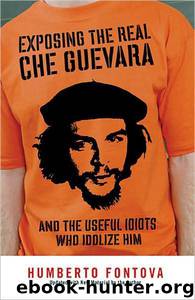Exposing the Real Che Guevara by Humberto Fontova

Author:Humberto Fontova
Language: eng
Format: mobi, epub
Tags: Political Science / Political Ideologies
ISBN: 9781595230522
Publisher: Sentinel
Published: 2007-04-18T22:00:00+00:00
Che’S Camps for “Delinquents”
“On October 9, 1967, the first news of Ernesto Che Guevara’s alleged death reached the United States,” recalls journalist John Gerassi, who taught at San Francisco State University. “I was approached by a nineteen-year-old coed. She had tears in her eyes and a ‘Make Love Not War’ button on her breast. ‘Do you think it’s true?’ ”27
Around the world, young idealists were in tears over a man who mandated perpetual war and universal military service for youth. “For me it was the most marvelous sight in the world,” wrote Che about a supply of machine guns delivered to his guerrilla column in Cuba’s Sierra mountains. “There under our envious eyes were the instruments of death!”28
An eighteen-year-old Cuban named Emilio Izquierdo got the news of Che’s death on the same day as Professor Gerassi’s class. But Emilio’s reaction was markedly different from the San Francisco flower child’s. “Oh, how I wanted to cheer!” he recalls from Miami today. “I wanted to jump up and down! To whoop with joy! To throw a party! To hug the very man who had given me the news!”
But that would have been very unwise. The news of Che’s death had been imparted to Emilio by a machine-gun-toting guard. Emilio, you see, was in a UMAP prison camp for “delinquents” and “lumpen” in October 1967. This penal system had been the brainchild of Che Guevara (the hero of students who want “no rule from above”) back in 1960 at a place called Guanahacabibes in extreme western Cuba.
Castro and Che’s “revolutionary justice” had made great strides in just one year. No bogus trials without defense counsel and with illiterate common criminals as judges condemned these prisoners, as they had thousands in 1959 to the firing squads and prisons. “We send to Guanahacabibes people who have committed crimes against revolutionary morals,” announced Che himself. “It is hard labor . . . the working conditions are harsh . . .” And that was that.29 “Rehabilitation” was the professed goal at Che’s forced-labor camps. Jon Lee Anderson uses the word without quotation marks and apparently with a straight face in his Che biography. Pol Pot and Ho Chi Minh preferred the term “re-education” for a similar process.
“Slave labor and torture” is the preferred term of Emilio Izquierdo and of the tens of thousands who suffered in similar camps before him, alongside him, and after him. Like Stalin’s Gulags, the prisons of Cuba filled up with tens of thousands of social parasites, loafers, and unreconstructed men. If this sounds familiar, recall Ernesto Guevara’s cheeky signature on his early correspondence as “Stalin II.”
In time, all of Cuba became a prison. Che instituted a “progressive” labor program of “volunteer” weekend work and sixty-hour workweeks that galled Cuba’s working class. Before their liberation by Che, Cuba’s workers had become accustomed to such working hours and benefits as to make Lane Kirkland and George Meany gape in envy. In fact, in the 1940s and 1950s, Cuban labor was more highly unionized, proportional to population, than U.
Download
Exposing the Real Che Guevara by Humberto Fontova.epub
This site does not store any files on its server. We only index and link to content provided by other sites. Please contact the content providers to delete copyright contents if any and email us, we'll remove relevant links or contents immediately.
| Anarchism | Communism & Socialism |
| Conservatism & Liberalism | Democracy |
| Fascism | Libertarianism |
| Nationalism | Radicalism |
| Utopian |
The Secret History by Donna Tartt(18951)
The Social Justice Warrior Handbook by Lisa De Pasquale(12170)
Thirteen Reasons Why by Jay Asher(8848)
This Is How You Lose Her by Junot Diaz(6837)
Weapons of Math Destruction by Cathy O'Neil(6220)
Zero to One by Peter Thiel(5736)
Beartown by Fredrik Backman(5682)
The Myth of the Strong Leader by Archie Brown(5461)
The Fire Next Time by James Baldwin(5386)
How Democracies Die by Steven Levitsky & Daniel Ziblatt(5175)
Promise Me, Dad by Joe Biden(5117)
Stone's Rules by Roger Stone(5053)
A Higher Loyalty: Truth, Lies, and Leadership by James Comey(4909)
100 Deadly Skills by Clint Emerson(4882)
Rise and Kill First by Ronen Bergman(4741)
Secrecy World by Jake Bernstein(4703)
The David Icke Guide to the Global Conspiracy (and how to end it) by David Icke(4658)
The Farm by Tom Rob Smith(4468)
The Doomsday Machine by Daniel Ellsberg(4452)
